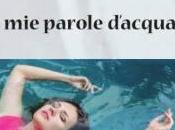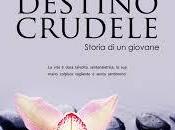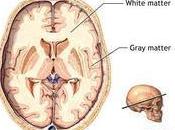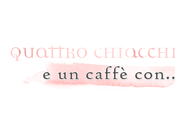Sebbene molti degli artisti presentati fossero stati celebrati come meraviglia vivente dai loro contemporanei, mancando in India una fonte biografica quale per esempio il nostro Vasari, oggi si conosce molto poco della vita di quegli artisti. La tradizione indiana poi di identificare le opere con una scuola, una corte o una bottega, rende ancora più difficile la missione di attribuire le opere ai singoli artisti.
Grazie ad anni di ricerche approfondite e alla decifrazione di microscopiche sigle o firme, e soprattutto grazie ad analisi stilistiche comparate, è stato possibile restituire una paternità precisa ai capolavori indiani e conoscere anche qualcosa in più sui loro autori. Come, per esempio, a proposito di Farrukh Beg, che dipinse in Iran, a Kabul, a Lahore, a Bijapur e ad Agra. O dei fratelli Manaku and Nainsukh, i quali, pur avendo entrambi appreso l'arte nella bottega del padre, il Pandit Seu, svilupparono stili decisamente differenti.
Nomi quali quelli di
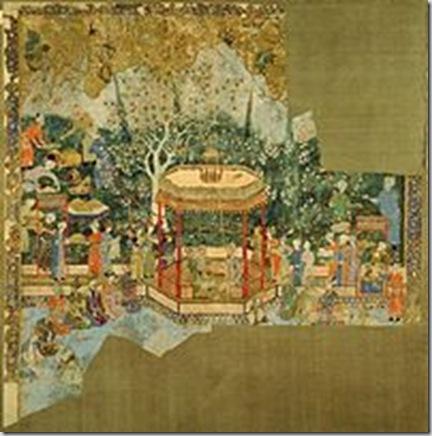 Abd al-Samad, Kripal o
Abd al-Samad, Kripal o 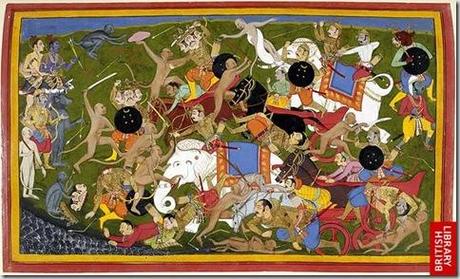
Sahibdin condivisero straordinarie raffinatezze tecniche, senso cromatico e notevolissime abilità compositive: non dovrebbe stupire, insomma, scoprire il fatto che Rembrandt possedesse una collezione di miniature indiane, perchè i Grandi Maestri dell'India non apparvero certamente ininfluenti nemmeno ai più noti ed attenti artisti occidentali.
Le opere in mostra provengono da collezioni quali quelle della Royal Collection of Windsor Castle, del Golestan Palace di Tehran o dell'Istituto per i Manoscritti Orientali di SanPietroburgo e l'esposizione verrà proposta dal 28 Settembre all'8 Gennaio 2012 anche al Metropolitan Museum of Art di New York, che ha collaborato alla sua realizzazione.
![clip_image001[4] clip_image001[4]](//m2.paperblog.com/i/36/365094/la-via-del-maestro-i-grandi-artisti-dellindia-L-_QQ_1Q.jpeg) Portrait of St. Jerome signed by Farrukh Beg, India 1615
Portrait of St. Jerome signed by Farrukh Beg, India 1615
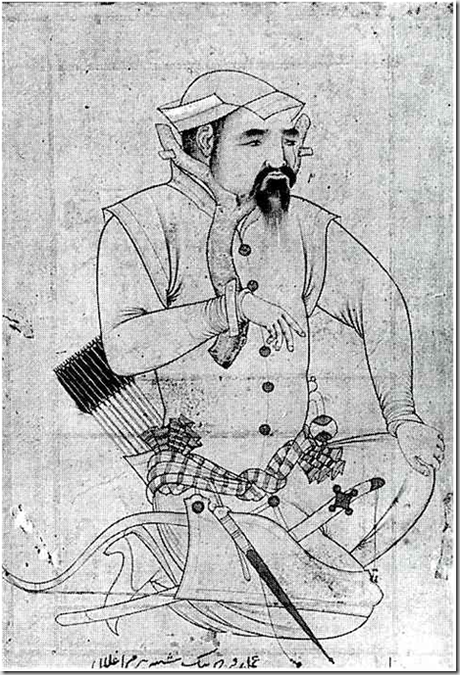
The Turkmen Prisoner- 1590 - 1600 Signed by Farrukh Beg. 1
![clip_image003[4] clip_image003[4]](http://m2.paperblog.com/i/36/365094/la-via-del-maestro-i-grandi-artisti-dellindia-L-5WWYQd.jpeg) A Drunken Babur Returns to Camp at Night, Farrukh Beg, 1589, Arthur M. Sackler Gallery (Online)
A Drunken Babur Returns to Camp at Night, Farrukh Beg, 1589, Arthur M. Sackler Gallery (Online)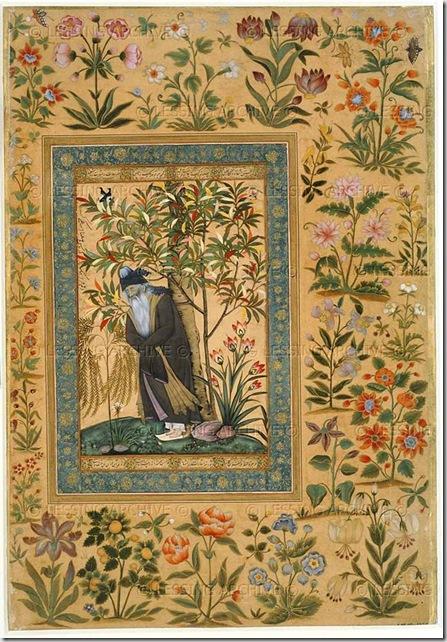 An aged Mullah. Opaque watercolour and gold on paper India or Pakistan; ca. 1615 Artist: Farrukh Beg, born ca. 1545 - died active 38.6 cm x 25.1 cm (page), 16.8 cm x 11.1 cm (picture only) Museum Number: IM.10-1925 Vedi: Victoria and Albert Museum, London, Great Britain
An aged Mullah. Opaque watercolour and gold on paper India or Pakistan; ca. 1615 Artist: Farrukh Beg, born ca. 1545 - died active 38.6 cm x 25.1 cm (page), 16.8 cm x 11.1 cm (picture only) Museum Number: IM.10-1925 Vedi: Victoria and Albert Museum, London, Great Britain Ibrahim Adil Shah
Ibrahim Adil Shah This portrait was done for a book for Emperor Jahangir. A note mentions: "Ibrahim Adil Khan of Deccan, Prince of Bijapur, who through his knowledge of music brought fame to Deccan and enlightment to his people." It was painted live in 1610 by Farrukh Beg.
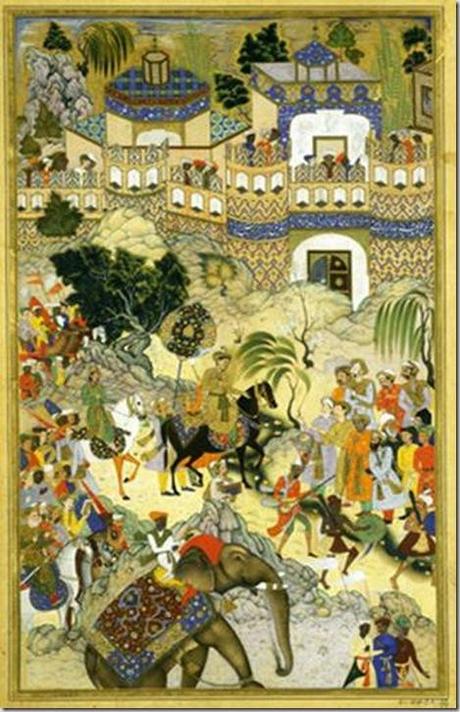 Akbar entry into Surat, by Farrukh Beg (1545-1615). Watercolour. Mughal, India, c.1590.
Akbar entry into Surat, by Farrukh Beg (1545-1615). Watercolour. Mughal, India, c.1590.  Self-Portrait and Portraits of Artists (detail) By Daulat, Mughal, c. 1610 © Golestan Palace Library, Tehran. Photo: Davood Sadeghsa
Self-Portrait and Portraits of Artists (detail) By Daulat, Mughal, c. 1610 © Golestan Palace Library, Tehran. Photo: Davood Sadeghsa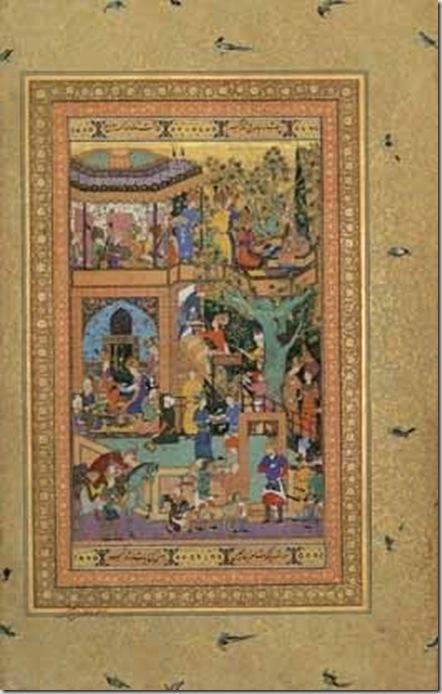 Akbar Presents a Painting to His Father Humayun. By ‘Abd al-Samad. Mughal, probably Kabul, c. 1550–1556. © Golestan Palace Library, Tehran. Photo: Davood Sadeghsa
Akbar Presents a Painting to His Father Humayun. By ‘Abd al-Samad. Mughal, probably Kabul, c. 1550–1556. © Golestan Palace Library, Tehran. Photo: Davood Sadeghsa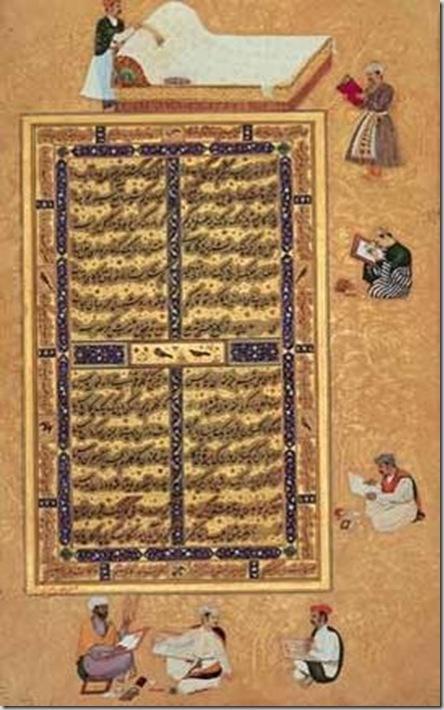 Self-Portrait and Portraits of Artists By Daulat, Mughal, c. 1610 © Golestan Palace Library, Tehran. Photo: Davood Sadeghsa
Self-Portrait and Portraits of Artists By Daulat, Mughal, c. 1610 © Golestan Palace Library, Tehran. Photo: Davood Sadeghsa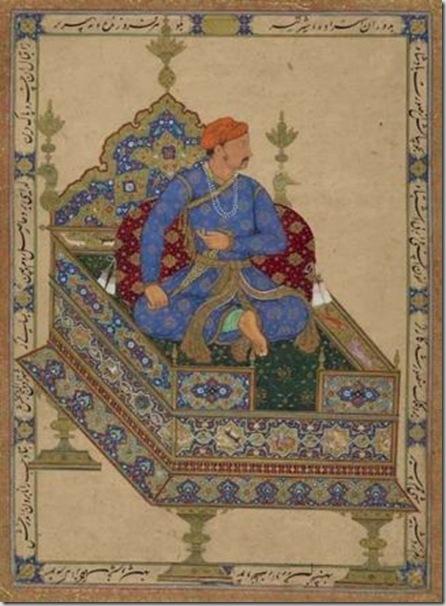 Prince Salim Enthroned. By Manohar (Portrait) and Mansur (Throne). Mughal, dated 1600/01 © The Institute of Oriental Manuscripts of the Russian Academy of Sciences, St. Petersburg, 2011
Prince Salim Enthroned. By Manohar (Portrait) and Mansur (Throne). Mughal, dated 1600/01 © The Institute of Oriental Manuscripts of the Russian Academy of Sciences, St. Petersburg, 2011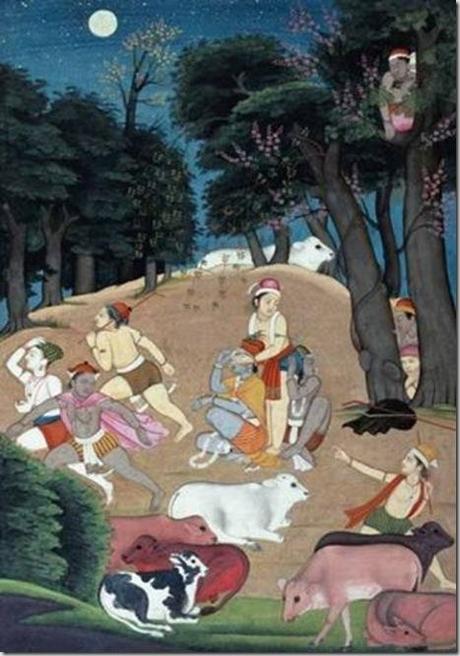 Krishna playing Blindman’s Bluff. By Manaku. Pahari region, Guler, c. 1750 © The Kronos Collections
Krishna playing Blindman’s Bluff. By Manaku. Pahari region, Guler, c. 1750 © The Kronos Collections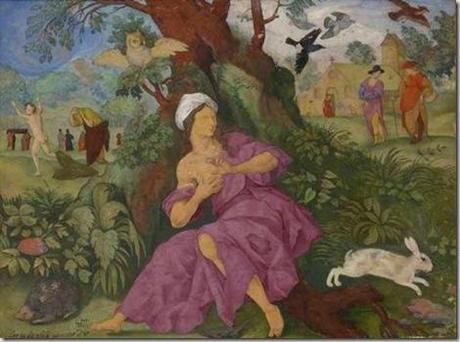 Dialectica. By Abu’l Hasan. Overpainted engraving by Marten des Vos, after Jan Sadeler. Mughal, c. 1602/03 © The Institute of Oriental Manuscripts of the Russian Academy of Sciences, St. Petersburg, 2011
Dialectica. By Abu’l Hasan. Overpainted engraving by Marten des Vos, after Jan Sadeler. Mughal, c. 1602/03 © The Institute of Oriental Manuscripts of the Russian Academy of Sciences, St. Petersburg, 2011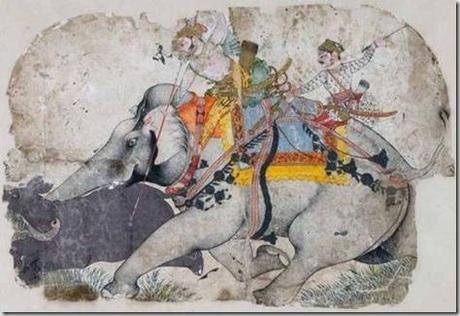 Ram Singh I of Kota Pursuing a Rhinoceros. Attributed to a Kota master.Rajasthan, Kota, c. 1700 © Private Collection
Ram Singh I of Kota Pursuing a Rhinoceros. Attributed to a Kota master.Rajasthan, Kota, c. 1700 © Private Collection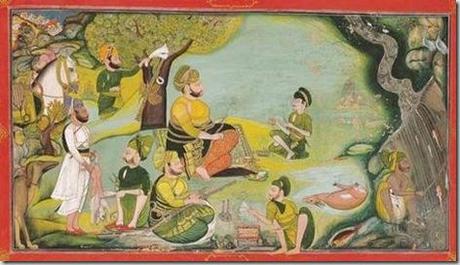 Rawat Gokul Das at a Hunting Party. By Bagta. Rajasthan, Mewar, Devgarh, dated 1808 © Trustees, Chhatrapati Shivaji Maharaj Vastu Sangrahalaya, Mumbai (Formerly Prince of Wales Museum of Western India)
Rawat Gokul Das at a Hunting Party. By Bagta. Rajasthan, Mewar, Devgarh, dated 1808 © Trustees, Chhatrapati Shivaji Maharaj Vastu Sangrahalaya, Mumbai (Formerly Prince of Wales Museum of Western India)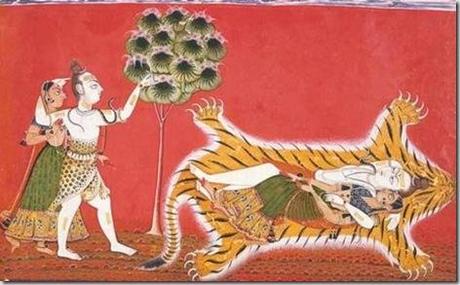 Shiva, Solicitous of his Other Half. By Devidasa. Pahari region, Basohli, dated 1695 © San Diego Museum of Art
Shiva, Solicitous of his Other Half. By Devidasa. Pahari region, Basohli, dated 1695 © San Diego Museum of Art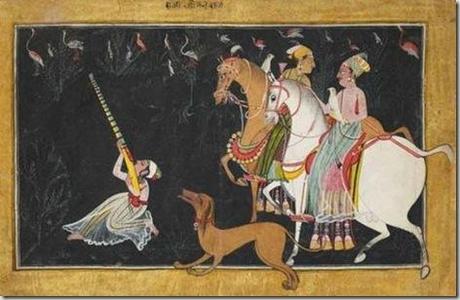 Rupmati and Baz Bahadur Hunting. Attributed to the First Bahu Master. Pahari region, Bahu, c. 1700 © Museum Rietberg Zürich, long-term loan Barbara and Eberhard Fischer. Photo: Rainer Wolfsberger
Rupmati and Baz Bahadur Hunting. Attributed to the First Bahu Master. Pahari region, Bahu, c. 1700 © Museum Rietberg Zürich, long-term loan Barbara and Eberhard Fischer. Photo: Rainer Wolfsberger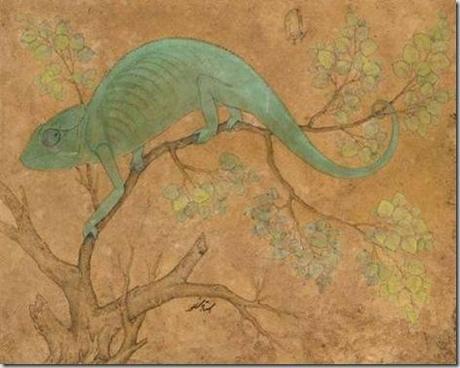 Chameleon. By Mansur. Mughal, c. 1595–1600. Royal Collection © 2011 Her Majesty Queen Elizabeth II
Chameleon. By Mansur. Mughal, c. 1595–1600. Royal Collection © 2011 Her Majesty Queen Elizabeth II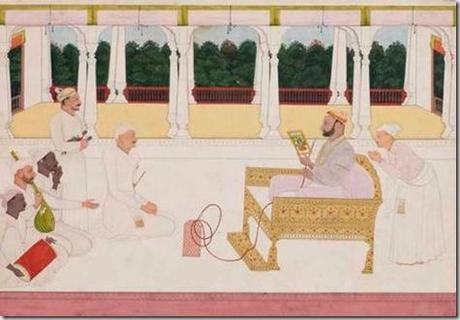 Raja Balwant Singh of Jasrota Contemplating a Painting with the Painter Nainsukh. Attributed to Nainsukh. Pahari region, Jasrota, c. 1745–1750 © Museum Rietberg Zürich. Photo: Rainer Wolfsberger
Raja Balwant Singh of Jasrota Contemplating a Painting with the Painter Nainsukh. Attributed to Nainsukh. Pahari region, Jasrota, c. 1745–1750 © Museum Rietberg Zürich. Photo: Rainer Wolfsberger Ascetics in the Dandaka Forrest. Master of the First Generation after Nainsukh and Manaku. Pahari region, Kangra/Guler, c. 1780 © Museum Rietberg Zürich, Collection Danielle Porret. Photo: Rainer Wolfsberger
Ascetics in the Dandaka Forrest. Master of the First Generation after Nainsukh and Manaku. Pahari region, Kangra/Guler, c. 1780 © Museum Rietberg Zürich, Collection Danielle Porret. Photo: Rainer Wolfsberger![clip_image001[4] clip_image001[4]](http://m2.paperblog.com/i/36/365094/la-via-del-maestro-i-grandi-artisti-dellindia-L-_QQ_1Q.jpeg) Portrait of St. Jerome signed by Farrukh Beg, India 1615
Portrait of St. Jerome signed by Farrukh Beg, India 1615